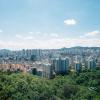
Options Winter 2021: While urbanization is a common cause of biodiversity decline, the Republic of Korea has managed to maintain its biodiversity during its rapid economic development. IIASA researcher Florian Kraxner and colleagues analyzed the persistence of plants in the country and constructed future scenarios to better prepare for the pressures of climate change.
Biodiversity loss has long been one of the most devastating consequences from land-use change due to human activities like urban and agricultural expansion, industry, and deforestation, and it has only been exacerbated by the effects of climate change. Remarkably, the Republic of Korea is a country that has managed to achieve rapid economic development while maintaining its biodiversity since initial reforestation efforts began after the Korean War. Although urban hubs like Seoul and Busan played a part in forest decline, overall, the quality of these forests has improved due to excellent continuous forest management.
IIASA researcher Florian Kraxner contributed to research analyzing the biodiversity persistence of plants in the Republic of Korea since the 1960s. National data sets were used to create spatial scenarios of past versus present land use and habitat quality. Additionally, researchers constructed future scenarios evaluating biodiversity persistence and the net effects of forest management on biodiversity.
The resulting scenarios displayed positive biodiversity persistence over the years, with the Korean government managing to offset the negative effects of urbanization through reforestation and habitat management efforts. The study also showed that the most serious consequences of climate change could be mitigated but that change is needed, as current management practices are not enough. Further research with more diverse future land-cover and land-use scenarios that would allow Korea to better prepare for a worst-case scenario was also recommended.
By Neema Tavakolian
